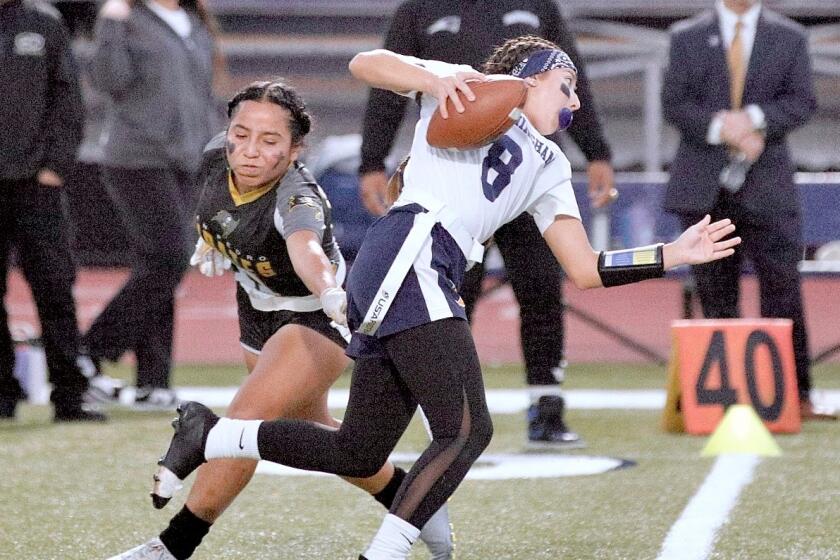Outdoors : NOTES : Great White Shark Landed by Angler
It was not an average day’s fishing off the Malibu coast for Bill Barlow.
The West Los Angeles resident had been fishing within 50 to 100 feet of the coastline off Sunset Beach for the past several days and knew there was something big in the water.
Tuesday afternoon he proved it.
Using progressively heavier gear each time out, Barlow finally managed--after a 1 1/2-hour fight--to land a 6 1/2-foot, 297-pound great white shark.
“And there’s one out there at least eight feet long and about 500 pounds,” Barlow said. “We had him right up to our boat before he broke the line. I’ve used progressively heavy tackle until I finally caught this one.”
Barlow subdued his shark--in just 14 feet of water--using 100-pound test monofilament with a 500-pound steel leader and dead mackerel as bait.
Don Nelson, a shark specialist with Cal State Long Beach, said the capture of a white shark of that size is not too surprising. “Occasionally the smaller ones are caught along the beaches,” he said, adding that the chances are slim of a much bigger shark looming just off the coast.
“(White sharks) don’t get mature until they’re 12 to 14 feet and the real big ones are normally found near the seal colonies or way out in the deep water,” Nelson said.
In October 1987, two white sharks slightly bigger than Barlow’s were caught off the Manhattan Beach coast on the same day. Experts said that was unusual because great whites generally travel alone.
It’s official. California’s trout fishermen will catch fewer fish in 1990.
As expected, the Department of Fish and Game’s proposal to reduce the limit to five fish daily in places where it had previously been 10, with 10 allowed in possession, was adopted Dec. 21 by the Fish and Game Commission.
While that might appear to be a blow to the fisherman who wants more fish, the decision was widely praised by most conservation-oriented groups.
“There was a lot of support (by them),” said Almo Cordone, the DFG’s inland fisheries management supervisor. Of the individual or unattached fishermen, Cordone said, “We’ll hear from them when they find out about it.”
The proposal was designed to spread the trout harvest among more anglers and allow the DFG to plant fewer, but larger, trout in public waterways, the DFG said in a release.
One major proposal rejected by the commission at the Dec. 21 hearing was one in which streams and reservoirs in Inyo and Mono counties would remain open year-round. Instead the season will still run from the last Saturday in April to Oct. 31.
Other noteworthy changes involving popular Eastern Sierra fisheries:
--A zero limit will go into effect on the heavily fished main portion of Cottonwood Creek, between the mouth of Little Cottonwood Creek and the mouth of the South Fork of Cottonwood Creek, to protect the golden trout fishery.
--Rush Creek will have special regulations whereby artificial lures only are allowed and fish over 10 inches must be released. “It has a big population of little fish,” Cordone said.
--The wild-trout section of Hot Creek gains a half-mile, now stretching to the DFG hatchery property line.
--All trout caught in the East Fork of the Walker River must be at least 14 inches. The size limit was 18 inches in the upper portion.
--Bear Creek and Deep Creek have an increased size limit from six to eight inches.
--Kirman Lake will be restricted to artificial lures, and a 16-inch minimum has been established.
Locally, a year-round, zero-limit rule goes into effect from the portion of Piru Creek slightly above the old Highway 99 Bridge upstream to the bridge slightly below Lake Pyramid. Only artificial lures may be used on that portion of the Los Angeles County creek.
There no longer will be a special season on Big Bear Lake’s tributaries--fishing will be allowed year-round.
And the Malibu Creek steelhead fishery will open the Saturday after Memorial Day and close on Nov. 15 instead of Nov. 30. A zero limit remains in effect.
In addition, the bag limit at most of Northern California’s salmon and steelhead streams has been reduced from either three or five, to two.
Cordone said there have been several changes statewide and that the 1990 sportfishing regulations booklets are available at DFG offices and tackle stores.
San Diego’s sportfishers are still plying Mexican waters for yellowtail--and still finding them in large quantities, which is unusual this late in the year.
Caryl Sandner of H&M; Landing said fishermen on some of the boats are getting their limits--five fish in Mexican waters--as early as mid-day.
The boats for the most part are traveling between 40 and 60 miles south of Point Loma, and most of the fish are between eight and 12 pounds, with some pushing 20.
Briefly
The bald eagle is making a comeback and may be removed from the endangered species list, according to Dan James of the U.S. Fish and Wildlife Service. “We now know of a minimum of 2,590 breeding pairs of bald eagles” in the lower 48 states, James said. “That probably translates to somewhere between 10,000 and 12,000 eagles.” The banning of the pesticide DDT in 1972 is considered the largest single factor.
H. Werner Buck’s 25th annual Anaheim Sports, Vacation & RV show will be held Jan. 6-14 at the Anaheim Convention Center.
More to Read
Go beyond the scoreboard
Get the latest on L.A.'s teams in the daily Sports Report newsletter.
You may occasionally receive promotional content from the Los Angeles Times.










